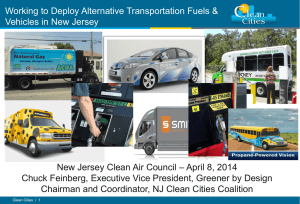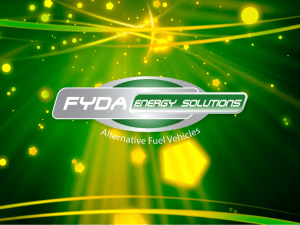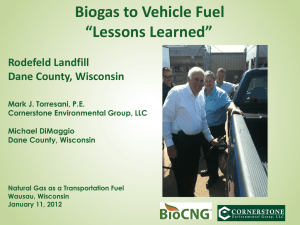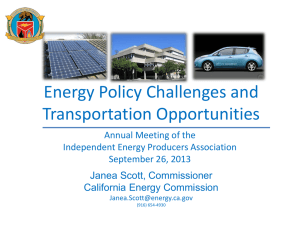Time line & Objectives
advertisement
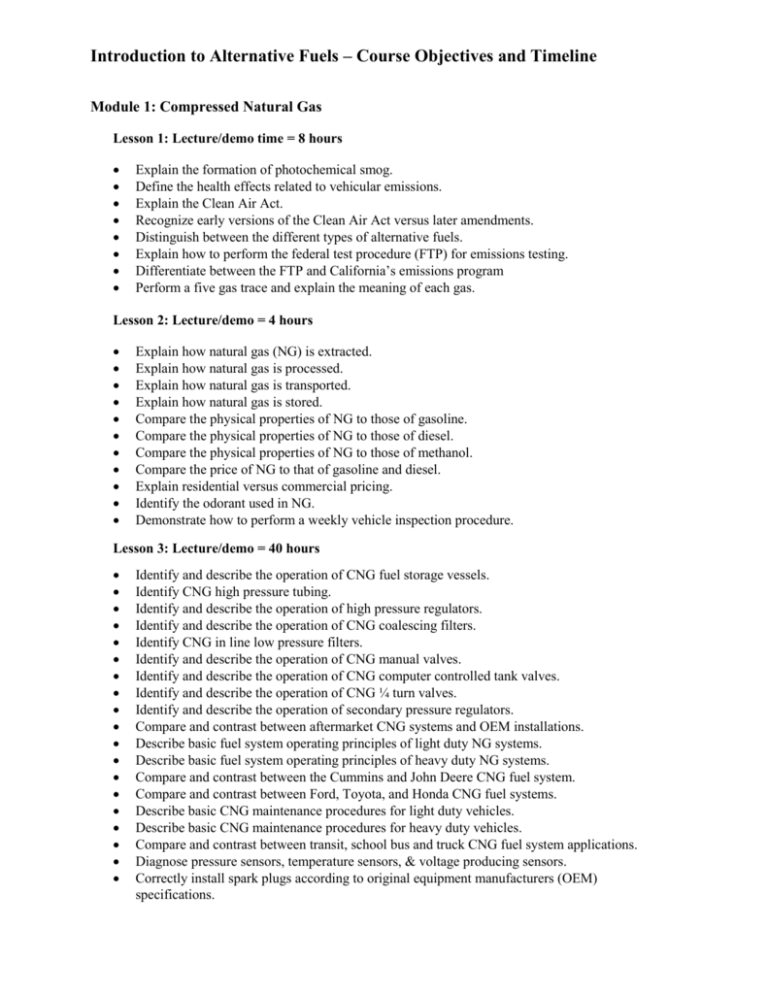
Introduction to Alternative Fuels – Course Objectives and Timeline Module 1: Compressed Natural Gas Lesson 1: Lecture/demo time = 8 hours Explain the formation of photochemical smog. Define the health effects related to vehicular emissions. Explain the Clean Air Act. Recognize early versions of the Clean Air Act versus later amendments. Distinguish between the different types of alternative fuels. Explain how to perform the federal test procedure (FTP) for emissions testing. Differentiate between the FTP and California’s emissions program Perform a five gas trace and explain the meaning of each gas. Lesson 2: Lecture/demo = 4 hours Explain how natural gas (NG) is extracted. Explain how natural gas is processed. Explain how natural gas is transported. Explain how natural gas is stored. Compare the physical properties of NG to those of gasoline. Compare the physical properties of NG to those of diesel. Compare the physical properties of NG to those of methanol. Compare the price of NG to that of gasoline and diesel. Explain residential versus commercial pricing. Identify the odorant used in NG. Demonstrate how to perform a weekly vehicle inspection procedure. Lesson 3: Lecture/demo = 40 hours Identify and describe the operation of CNG fuel storage vessels. Identify CNG high pressure tubing. Identify and describe the operation of high pressure regulators. Identify and describe the operation of CNG coalescing filters. Identify CNG in line low pressure filters. Identify and describe the operation of CNG manual valves. Identify and describe the operation of CNG computer controlled tank valves. Identify and describe the operation of CNG ¼ turn valves. Identify and describe the operation of secondary pressure regulators. Compare and contrast between aftermarket CNG systems and OEM installations. Describe basic fuel system operating principles of light duty NG systems. Describe basic fuel system operating principles of heavy duty NG systems. Compare and contrast between the Cummins and John Deere CNG fuel system. Compare and contrast between Ford, Toyota, and Honda CNG fuel systems. Describe basic CNG maintenance procedures for light duty vehicles. Describe basic CNG maintenance procedures for heavy duty vehicles. Compare and contrast between transit, school bus and truck CNG fuel system applications. Diagnose pressure sensors, temperature sensors, & voltage producing sensors. Correctly install spark plugs according to original equipment manufacturers (OEM) specifications. Introduction to Alternative Fuels – Course Objectives and Timeline Lesson 4: Lecture/demo = 6 hours Identify ¼ in high pressure stainless steel tubing. Identify 3/8 in high pressure stainless steel tubing. Identify ½ in high pressure stainless steel tubing. Site NFPA-52 regulations applicable to high pressure tubing. Compare and contrast between Hoke and Swagelok fastening systems. Describe how to properly use Hoke fittings. Describe how to test Hoke fittings for proper installation. Describe how to properly use Swagelok fittings. Describe how to test Swagelok fittings for proper installation. Install tubing according to NFPA – 52 regulations. Recite the tube bending formula for proper tubing installation. Compare and contrast LNG versus CNG tubing types. Compare and contrast LNG versus CNG tubing installation. Describe how to apply the proper thread sealants for LNG fitting applications. Lesson 5: Lecture/demo = 8 hours Compare and contrast between fast and slow fill stations. Compare and contrast between 3000 and 3600 psi fueling and vehicle systems. Describe the operation and major components of 3600 psi fill stations. Describe the operation and major components of 3000 psi fill stations. Describe the operation and major components of home refueling appliances. Describe fueling facility safety maintenance practices. List basic fueling facility maintenance practices. Compare and contrast fast fill, slow fill and home refueling appliance operation. Compare and contrast the different types of fuel vessels. Apply NFPA-52 rules and regulations applicable towards fueling facilities. Apply NFPA-52 rules and regulations applicable towards fuel vessels. Site NFPA-52 regulations applicable to high pressure tubing. Operate a slow fill fuel pump when refueling a vehicle. Operate a fast fill pump in refueling a vehicle. Operate a home refueling appliance when refueling a vehicle. Describe the operation of manual tank valves. Describe the operation of ¼ turn valves. Describe the operation of electrical/electronic tank valves. Describe the operation of one way check valves. Lesson 6: Lecture/demo = 4 hours Compare and contrast between local State and Federal regulations pertinent to CNG fueling site safety. List local city requirements for the operation of a CNG fueling station. List local city regulations/requirements for the operation and repair of CNG vehicles during fleet operations. List local fire department requirements for the operation of a CNG fueling station/s. List local city regulations for the operation and repair of CNG vehicles during fleet operations. Introduction to Alternative Fuels – Course Objectives and Timeline Explain NFPA – 52 rules and regulations applicable towards CNG site safety. Explain NFPA – 52 rules and regulations applicable towards fueling facilities. Explain NFPA – 52 rules and regulation applicable toward home refueling. Explain regulations applicable towards CNG fueling and general station equipment. Module 2: Liquefied Natural Gas Lecture/demo = 20 hours Explain LNG fuel vessel construction. Distinguish between pressure and level gauges attached to the fuel vessel. Define and explain, according to NFPA 52, how to properly mount LNG fuel vessels. Explain Boyles Law. Explain Charles Law. Explain the Pressure Law. Explain the Saturation Line. Explain the operating characteristics of a pressure relief device. Explain the theory and operation of an evacuation plug. Explain the theory and operation of a manual shut-off valve. Explain the theory and operation of an excess flow valve. Explain the theory and operation of a manual vent valve. Explain the theory and operation of a systems check valve. Explain the theory and operation of an economizer valve. Explain the theory and operation of a vaporizer assembly. Explain the theory and operation of fuel shut-off solenoids. Describe the proper safety attire needed during refueling. Describe how to properly attach a fueling nozzle. Describe how to properly refuel an LNG vehicle. Describe how to perform an insulation test on a LNG fueling vessel. Module 3: Biofuels Lesson 1: Lecture/demo time = 8 hours Explain the formation of photochemical smog. Define the health effects related to vehicular emissions. Distinguish between the different types of alternative fuels. Explain the economics of producing a domestic fuel source. Discuss “energy independence”. Explain ethanol production from algae. Explain ethanol production from sugar and starch crops. Explain ethanol production from cellulosic bio mass. Explain the political ramifications of ethanol production and alternative fuels. Compare and contrast ethanol with other viable fuels. Discuss various OEM “flex fueled” vehicles. Introduction to Alternative Fuels – Course Objectives and Timeline Lesson 2: Lecture/demo time = 12 hours Compare and contrast emissions from diesel and bio-diesel. Explain the negative health effects from particulate matter. Explain the negative health effects from NOx emissions. Describe specialized emissions equipment on diesel or bi-diesel fueled vehicles. Compare and contrast diesel and green diesel fuels. Compare and contrast green diesel and bio-diesel fuels. Compare and contrast refinement processes between fuels. Compare and contrast energy fuels and their respective properties. Discuss the “fuel or food” topic Discuss farming issues related to bio fuels production. Explain energy yields per yield of plant based bio-diesel. Explain OEM bio-diesel use policy. Discuss OEM warranty issues related to bio-diesel. Module 4: Hybrid, Electric and Fuel Cell Vehicle Technology Lesson 1: Lecture/demo = 6 hours Describe past electric vehicles and their performance characteristics. Describe past bio-fueled vehicles and their performance characteristics. Describe past gasoline fueled vehicles and their performance characteristics. Compare and contrast past and present electric vehicles. Compare and contrast past and present bio-fueled vehicles. Compare and contrast past and present hydrocarbon fueled vehicles. Explain current hybrid vehicle operating characteristics. Describe future electric vehicles. Explain how a fuel cell works. Lesson 2: Lecture/demo = 20 hours Describe light and heavy duty hybrid vehicle safety standards according to SAE. Compare and contrast emissions between conventional internal combustion engines and hybrid drivetrains, both light and heavy duty. Compare and contrast fuel economy between conventional internal combustion engines and hybrid drivetrains, both light and heavy duty. Differentiate between hybrid vehicle highway and city fuel mileage. Explain basic operating principles of the Toyota Synergy hybrid drivetrain. Describe the operating strategy for the Toyota hybrid battery pack. Compare and contrast battery architecture for various hybrid vehicle platforms. Compare and contrast a conventional cooling system versus the cooling system found on Toyota’s hybrid Synergy drive. Explain basic operating principles of the Honda hybrid drivetrain. Describe the operating strategy for the Honda hybrid battery pack. Explain basic operating principles of the Nissan hybrid drivetrain. Introduction to Alternative Fuels – Course Objectives and Timeline Describe the operating strategy for the Nissan hybrid battery pack. Explain basic maintenance procedures for hybrid vehicle platforms. Compare and contrast competing hybrid vehicle operating strategies. Explain basic operating principles of the GMC hybrid drivetrain. Describe the operating strategy for the GMC hybrid battery pack. Describe heavy duty hybrid drivetrains for hybrid applications. Compare and contrast heavy duty hybrid drivetrain platforms for both transit and truck application. Describe the cooling system requirements for heavy duty hybrid drivetrains. Compare and contrast between light and heavy duty hybrid vehicle electronic controls. Describe heavy duty hybrid vehicle drivetrain theory of operation. Compare and contrast energy storage systems between light and heavy duty applications. Describe the pros and cons of using capacitor packs for energy storage. Use a service diagnostic scan tool to interpret needed repairs. Interpret and apply trouble shooting charts to make repairs. Lesson 3: Lecture/demo = 8 hours Describe light and heavy duty electric vehicle safety standards according to SAE. Describe personal protective equipment (PPE). Compare and contrast emissions between conventional internal combustion engines and electric drivetrains, both light and heavy duty. Compare and contrast fuel economy between conventional internal combustion engines and electric vehicle drivetrains, both light and heavy duty. Compare and contrast between electric vehicle highway and city fuel mileage. Discuss vehicle charging times and procedures. Explain local and federal legislation pertaining to electric vehicles. Compare and contrast emissions from hydrocarbon based fueled vehicles and charging stations. Explain common electrical/electronic components. Explain common battery technology. Compare and contrast hybrid vehicles with dedicated electric vehicles. Compare and contrast electric with internal combustion vehicles and other modern technology. Compare and contrast various OEM electric vehicle technology. Compare and contrast internal combustion vs. electric vehicle maintenance. Compare and contrast engine and electric motor durability tests. Describe electric vehicle A/C system operation. Compare and contrast the Chevy Volt to other electric vehicle platforms. Lesson 4: Lecture/demo = 10 hours Describe light and heavy duty fuel cell electric vehicle safety standards according to SAE. Describe personal protective equipment (PPE). Compare and contrast emissions between conventional internal combustion engines, all electric drivetrains, and fuel cell electric powerplants. Compare and contrast fuel economy between conventional internal combustion engines, electric vehicle, and fuel cell platforms. Compare and contrast fuel mileage between electric, hybrid, internal combustion, and fuel cell vehicle platforms. Explain vehicle fueling times and procedures. Introduction to Alternative Fuels – Course Objectives and Timeline Compare and contrast 3600, 5000, and 10,000 PSI rated fuel vessel technology. Discuss traction motor technology. Compare and contrast electrical/electronic “common components”. Discuss battery technology common to the electric, hybrid and fuel cell industries. Explain local and federal legislation pertaining to electric, hybrid and fuel cell vehicles. Compare and contrast the emissions footprint of fuel cell vehicles. Compare and contrast various OEM fuel cell technologies. Compare and contrast various fuel cell technologies.

